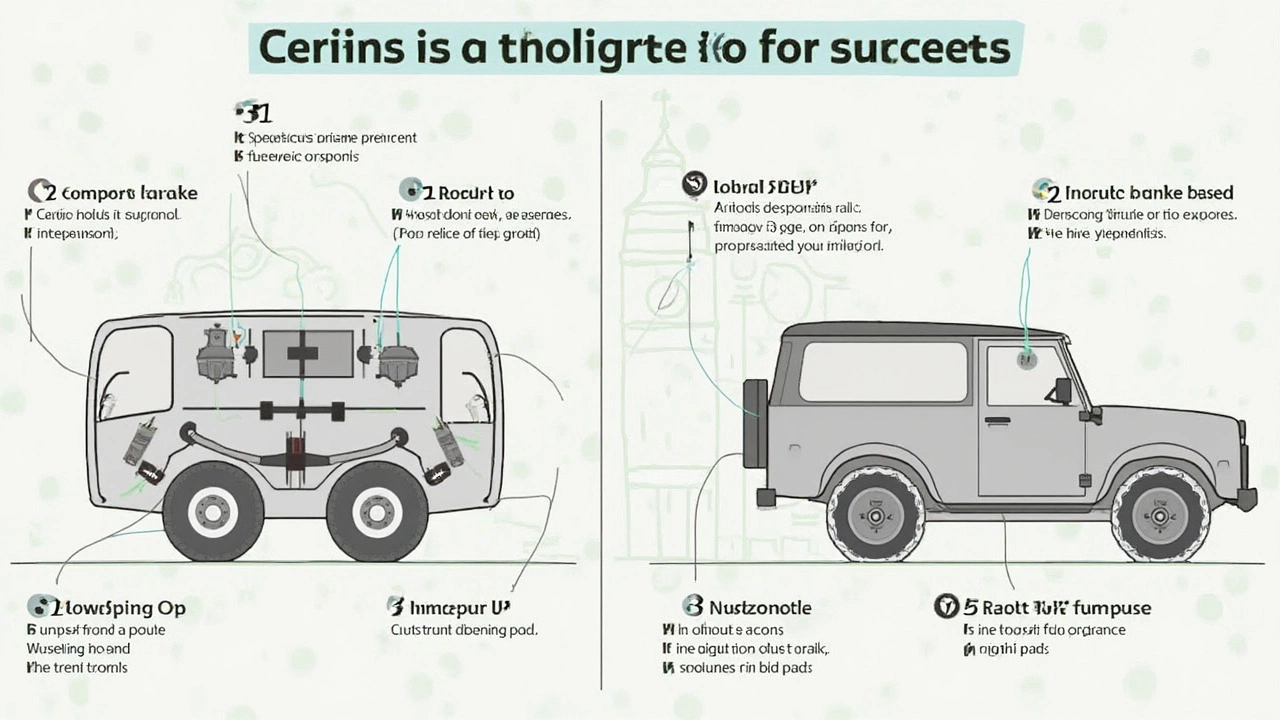If you've ever found yourself wondering, 'Do I need 4 or 8 brake pads?', you're not alone. It's a common question, especially for those new to car maintenance. Let's put it simply: the number of brake pads your vehicle needs depends on how the brake system is set up.
Most passenger cars have a disc brake system that uses two pads per wheel. So, a standard vehicle with four wheels typically requires 8 brake pads. But wait—why do some folks say 4? That's because they might be referring to only changing the front or the rear sets at a time, not the total needed for the whole car.
Why does this matter? Well, knowing how many brake pads your car needs helps you avoid overspending or worse, under-maintaining your car's brake system. In some vehicles, especially higher-end models or SUVs, you might have a combination of disc and drum brakes, which alters the number of pads and components needed.
- Understanding Brake Pad Basics
- Determining the Number of Brake Pads Needed
- Types of Brake Systems
- Cost and Maintenance Considerations
- Tips for Brake Pad Maintenance
Understanding Brake Pad Basics
Brake pads are a crucial component of your car's braking system. They grip the rotors and create the friction needed to slow down and stop your car. Without functioning brake pads, you'd have a hard time controlling your vehicle safely.
What Are Brake Pads Made Of?
Brake pads typically come in three types: organic, semi-metallic, and ceramic. Each type has its pros and cons. Organic brake pads are made from a blend of fibers and materials, making them quieter but less durable. Semi-metallic pads contain metal fibers, offering great performance and durability, though they can be noisier. Lastly, ceramic pads provide a good balance, they are quiet and long-lasting, but usually more expensive.
How Brake Pads Work
When you press the brake pedal, the brake system pushes hydraulic fluid to the caliper, squeezing the pads against the rotor. This contact slows the wheel, allowing the vehicle to stop. It's fascinating how just a few well-placed components can ensure safety on the road!
According to the Brake Manufacturers Council, "Regular brake checks are an essential part of car safety – outdated or thin brake pads can drastically reduce stopping power."
Since the brake pads bear the brunt of each stop, they tend to wear out over time. That's why regular inspections are critical. Most mechanics suggest checking your brake pads every 10,000 to 12,000 miles, though this can vary based on how and where you drive.
Signs You Need New Brake Pads
- Squeaking or squealing noise when braking.
- Vibration during stops.
- Longer stopping distances.
- Visible wear when inspecting through wheel spokes.
Ensuring your brake pads are in good shape isn't just about keeping you safe; it's also a smart way to avoid expensive repairs down the line. With the right care, you can keep your vehicle safe and efficient on the road.
Determining the Number of Brake Pads Needed
The first step in figuring out how many brake pads you need is understanding your car's brake system. Most vehicles on the road today use disc brakes on all four wheels. This setup requires two brake pads per wheel. If you do the math, that sums up to eight brake pads for the entire car.
Checking Your Car's Brake Setup
But life isn’t always that straightforward, right? Some cars, especially older models or budget-friendly vehicles, may have disc brakes at the front and drum brakes at the rear. In that case, you might only be dealing with four brake pads up front, while the rear wheels use brake shoes inside a drum.
- Disc brakes: Require 2 pads per wheel.
- Drum brakes: Use brake shoes; no pads required.
An easy way to know your setup is to consult your vehicle's manual or check with a professional mechanic.
Front vs. Rear Brake Pads
Did you know that your front and rear brake pads wear differently? The front brakes handle most of the stopping force when you brake, which means they generally wear out faster. Rear brakes, on the other hand, tend to last longer. So often, you might find yourself replacing the front pads more frequently.
Specific Vehicle Examples
If you're driving a compact car like a Ford Fiesta, you're likely looking at a four-disc brake setup. Meanwhile, a larger SUV or a pickup truck might come with disc brakes up front and drums in the back, depending on the model and its trim level. Always consider these differences when assessing the number of brake pads you need.
To get a clearer picture, here's a quick breakdown:
| Vehicle Type | Typical Brake Setup | Number of Brake Pads Needed |
|---|---|---|
| Compact Car | All Disc | 8 Pads |
| Mid-size SUV | Disc Front, Drum Rear | 4 Pads, 2 Drum Shoes |
By analyzing these factors, you can determine exactly how many brake pads your car needs, helping you save money and maintain optimal vehicle safety.

Types of Brake Systems
Understanding your car's brake system can save you time and money. Most cars today use a disc brake system. They're reliable, easy to maintain, and most importantly, they stop your car effectively.
Disc Brakes
These are the most common types in modern vehicles. They use a brake pad that clamps onto a rotor, creating friction that stops your car. Each wheel needs two pads, which is why a typical four-wheel setup needs 8 pads. Disc brakes are praised for their efficiency and better performance in wet conditions.
Drum Brakes
Drum brakes, often found on older or budget-friendly cars, use shoes that press outward against a spinning drum. They’re more common on rear wheels, as the back doesn’t require as much stopping force. With drum brakes, you might only have four brake pads, referred to as shoes in this context, especially if your vehicle has a mix of disc and drum systems.
How to Tell What You Have
- Check your owner's manual—it's got car-specific info.
- Peek through the wheel, if you see shiny flat discs, it's disc brakes.
- Drum brakes show a solid drum-shaped cover.
This handy table gives a quick side-by-side comparison of the two:
| Disc Brakes | Drum Brakes | |
|---|---|---|
| Performance | Great in all conditions | Decent, less effective when wet |
| Maintenance | Simple, pads are easy to replace | More complex, shoes take longer to change |
Both systems have benefits and drawbacks, but understanding yours lets you maintain your vehicle better. Keep in mind, regardless of the type, regular vehicle maintenance ensures your brakes last longer and perform at their best.
Cost and Maintenance Considerations
When thinking about your brake pads, it's not just the number you need to consider but also the costs involved, both upfront and over time. Regular maintenance can save you a bundle in the long run, yet many people overlook this until something goes wrong.
The Cost of Different Types of Brake Pads
Brake pads come in various types, like ceramic, semi-metallic, and organic. Each has its own price range and performance level. Ceramic brake pads generally cost more because they're quieter and produce less dust. Semi-metallic pads are cheaper but might wear down your rotors faster. Organic pads are the budget-friendly option but might not last as long.
| Type of Brake Pad | Average Cost (per set) |
|---|---|
| Ceramic | £70 - £150 |
| Semi-Metallic | £30 - £80 |
| Organic | £20 - £60 |
Choosing the right type depends on your driving habits and what's most important to you: cost, noise, or longevity.
Long-Term Savings with Regular Maintenance
Regular check-ups can greatly extend the life of your car brakes. It's generally recommended to have them inspected every 10,000 miles or when you rotate your tires. This way, you can catch any wear and tear before it becomes a safety hazard or leads to more costly repairs.
Tips for Efficient Maintenance
- Listen for squeaking or grinding noises, which are tell-tale signs you need new pads.
- Keep a schedule: Mark your calendar for brake checks every six months.
- Use reliable brands known for durability.
- Pay attention to the dashboard signals indicating brake issues.
Certainly, spending a bit on timely maintenance can prevent bigger expenses down the line. So, whether you're looking at new vehicle maintenance or simply trying to keep your current car in top shape, understanding the costs and upkeep of brake pads is a smart move. It can save you money and give you peace of mind knowing your car's brakes are in optimal working condition.

Tips for Brake Pad Maintenance
Keeping your brake pads in top shape is crucial for your car's performance and safety. Regular checks can prevent costly repairs down the line and ensure you don't end up in a tricky spot on the road.
Check for Wear and Tear
Your brake pads will naturally wear down over time. It's a smart move to inspect them whenever you have the wheels off. Look for thinning pads or uneven wear, which could signal it's time for replacements.
Listen for Unusual Noises
Car making strange squealing or grinding sounds when braking? It's likely your brake pads telling you they need attention. These noises can indicate the pads are worn down and may start damaging the rotors.
Keep Rotors Healthy
Rotors and brake pads work together, so if you're changing the pads, it's worth checking the rotors too. Warped or damaged rotors can reduce braking efficiency and cause uneven pad wear.
Consistency is Key
For consistent performance, always replace brake pads in sets of four on the same axle. Mixing old and new parts can lead to unpredictable braking behavior.
Schedule Regular Maintenance
Even if you're not a car enthusiast, regular check-ups are a must. See a professional at least once a year to ensure everything's in working order.
Brake Pad Types Matter
The type of brake pads you choose affects your car's stopping power and lifespan. Consider if ceramic, semi-metallic, or organic pads best suit your driving style and vehicle needs.
| Type | Pros | Cons |
|---|---|---|
| Ceramic | Long-lasting, quiet | More expensive |
| Semi-Metallic | Good durability, affordable | Noisier |
| Organic | Quiet, soft on rotors | Wears faster |

